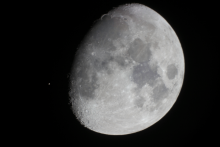Listen to today's episode of StarDate on the web the same day it airs in high-quality streaming audio without any extra ads or announcements. Choose a $8 one-month pass, or listen every day for a year for just $30.
You are here
Moon, Mars, and Aldebaran
Aldebaran is a close neighbor. The bright orange eye of Taurus, the bull, is about 65 light-years away. In other words, the light we see from Aldebaran tonight actually left the star about 65 years ago. Despite decades of measurements, though, there’s still some uncertainty in that number — about one light-year. So if a starship headed for Aldebaran today, it could miss its target by up to six trillion miles.
That shows how tough it is to measure the distances to the stars.
The main technique that astronomers use is known as parallax. In essence, they look at a star’s position compared to the background of other stars when Earth is on opposite sides of the Sun. It’s like holding a pencil in front of your face, and then looking at it with first one eye, then the other. The pencil shifts position against the background of more-distant objects — and so does a star. The size of the shift reveals the star’s distance.
The parallax of Aldebaran is about 50 milliarcseconds — roughly one seventy-thousandth of a degree. That’s an extremely difficult angle to measure even with space telescopes, which avoid the blurring effect of Earth’s atmosphere. So even the tiniest flaw in measuring that angle can make a big difference in the star’s distance.
But no matter how far it is, Aldebaran is in good view early this evening. It stands below the Moon as night falls, so it’s easy to spot. The fainter planet Mars stands to the right of Aldebaran.
Script by Damond Benningfield



